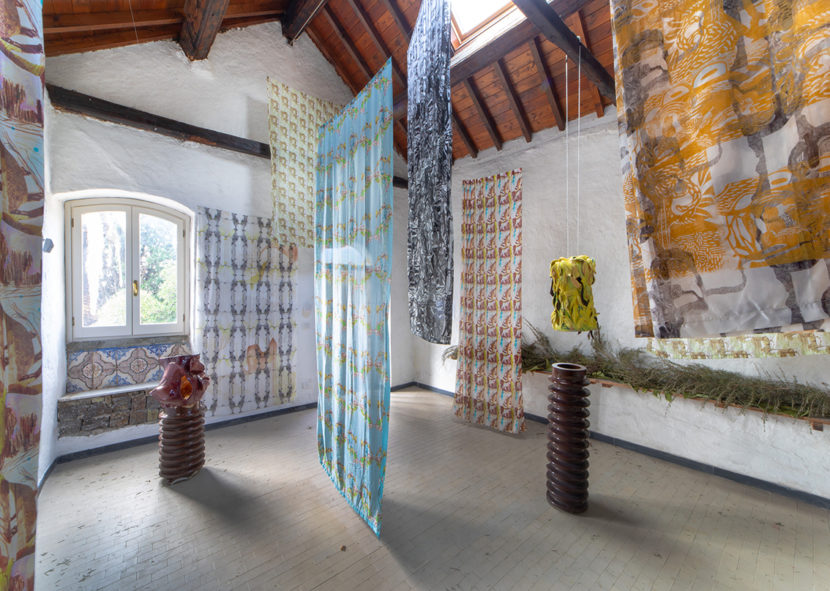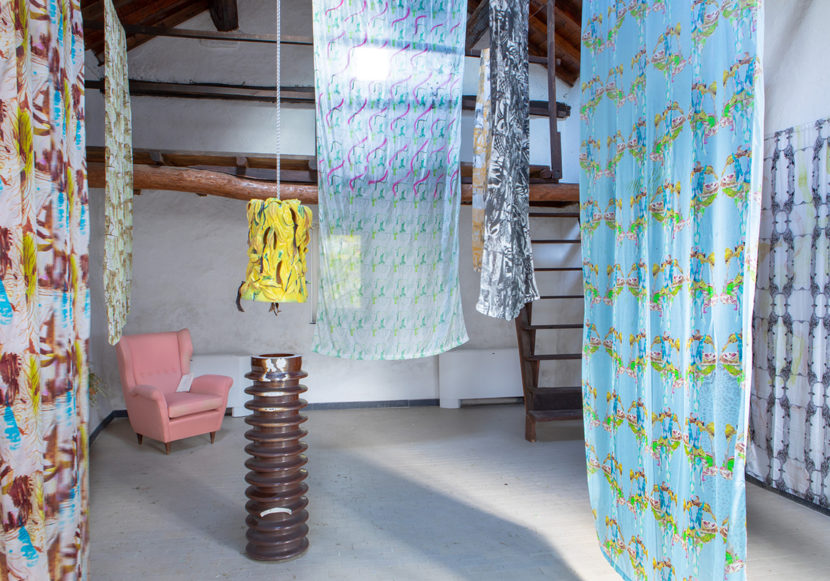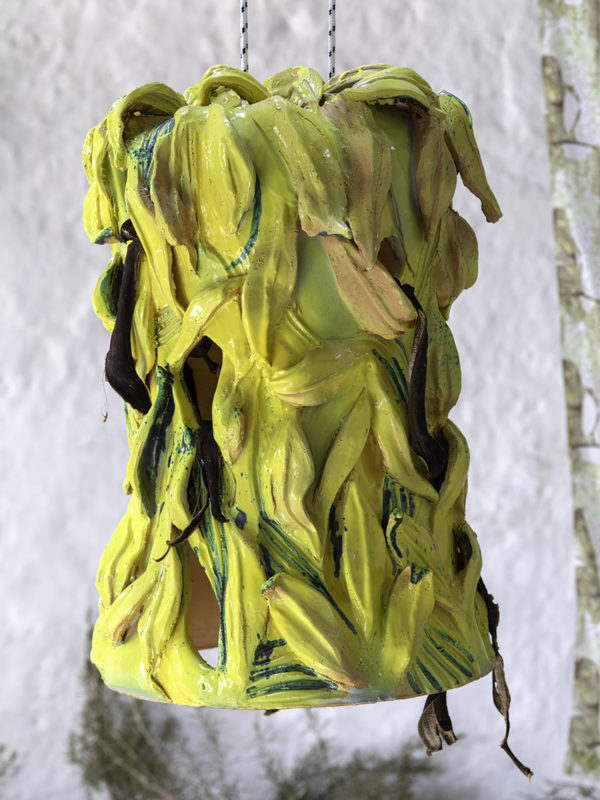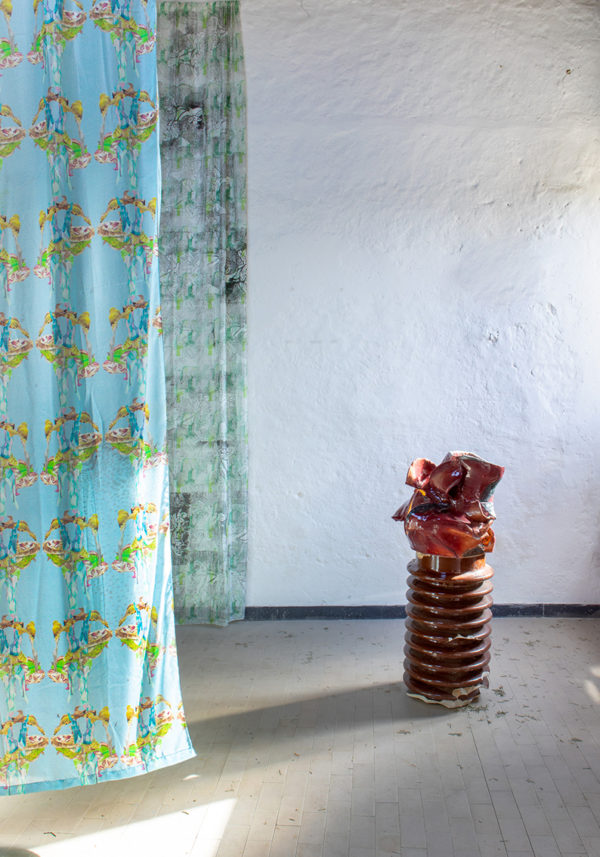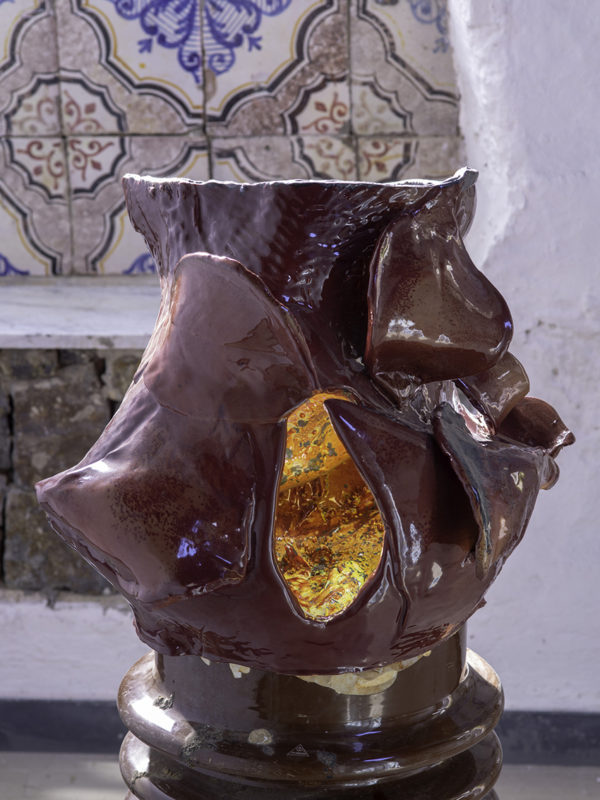Process and form
Asger Jorn house museum
October 7th – November 18th 2018
Solo show
Curated by Luca Bochicchio
Ph Matteo Zarbo
Fall season at the Asger Jorn House Museum starts with a room dedicated to the intervention by Alessandro Roma (Milan 1977). The Museo Diffuso of Albissola Marina (which Jorn House Museum is part of) is a public museum network which includes private venues and collections of historical value. Amongst the latter, the ceramic manufacture Giuseppe Mazzotti 1903 joined and contributed to the present project, providing Alessandro Roma with the technical and material support in the realization of two new sculptures. Jorn’s studio (a suggestive room at the first floor in one of the two ancient buildings that, along with the garden, composed the Danish artist’s Italian home) houses an installation rising from the most recent contamination work carried out by Roma during some residencies in three important Italian cities of ancient ceramic tradition: Albissola, Faenza and Montelupo Fiorentino. While in Faenza and Montelupo the artist attended specific artist-in-residence programs (respectively organized by MiC, and by the Montelupo Ceramics Museum Foundation), Roma went to Albissola for the first time in 2011, ideally following the trend inaugurated by the avant-garde protagonists on the early 20th century. Since then, artists have been choosing Albissola to produce their works at the artisans’ kilns as well as the industrial factories. In the last seven years, Roma has been going to Albissola in different periods to work at one of the manufactures, the Giuseppe Mazzotti 1903, which has built its identity on the relationship between handicraft, avant-garde and design. The intervention has been conceived for Jorn House Museum in the frame of the solo show recently inaugurated at the MiC in Faenza (Vertigo. Walking on the edge of the tone, curated by Irene Biolchini, up to October 21st). It is a single installation composed by two sculptures made out of ceramic, realized last summer in Albissola and never exhibited until today, along with some painted fabrics which change the perception of the space within Asger Jorn’s studio. The title of such intervention, PROCESS AND FORM, seal up the encounter between Roma’s work and the one Jorn made during his stay in his house in Albissola (transformed with a Situationist and wild approach with the help of Jorn’s friend and assistant Umberto Gambetta, from 1957 to 1973). Painting as a “mental” issue (as well as visual, or actually because visual) has been a concept clear to artists at least from Leonardo Da Vinci, moving on up to Matisse and beyond. From the early 20th century on, avant-garde’s explorations have in turn break and stitched up the modernist idea of the coherent progress of art in an evolutionary aesthetic. Alessandro Roma’s work has been chosen to face and interact with Jorn House Museum’s environment due to his conceptual research upon painting, which is a sort of interior contest between the mental rebuilding of the image and the deconstruction of the form. Form, process, structure (as well as painting, sculptures and decoration), are aesthetic categories which Jorn had always challenged both in his texts and in his daily artistic works (above all, his house and garden in Albissola). Since Roma’s reflection upon painting – and from collage to canvas, from fabrics to ceramics, for him it is always a matter of painting – always uses nature as a starting point (from contemplation to analysis), the nature enclosed in Jorn’s garden gives back itself, as a mirror, within the Studio, which appears modified by the intervention of another artist who, several years after Jorn, is searching in the process the reason of the formal expression. “Time” factor might be detected as a further key point in the interpretation of Roma’s installation: the delicate fluctuating of the fabrics in the space, contrasting with the forms of sculptures, almost frozen in the ceramic process, defuses the chronological fixity of a static observation. To strength this aspect, during the opening on October 6th Roma will include the romantic atmospheres of Emily Dickinson’s poetry, which will arise as a performative reading from the top of the exhibition space.
IT
Casa Museo Jorn apre la programmazione artistica autunnale con una sala dedicata all’intervento di Alessandro Roma (Milano 1977). Il Museo Diffuso di Albissola Marina (di cui Casa Museo Jorn fa parte) è una rete museale pubblica che vede la straordinaria partecipazione di sedi e collezioni storiche private. Una di queste realtà, la manifattura ceramica Giuseppe Mazzotti 1903, ha aderito e contribuito a questo progetto, fornendo ad Alessandro Roma il supporto tecnico e materiale per la realizzazione di due sculture inedite. Lo Studio di Jorn (una suggestiva stanza al primo piano di uno dei due antichi edifici che, insieme al giardino, componevano la residenza italiana dell’artista danese) ospita un’installazione frutto del più recente lavoro di contaminazione portato avanti da Roma in una serie di residenze che hanno toccato tre importanti città della ceramica italiane: Albissola, Faenza e Montelupo Fiorentino. A differenza di Faenza e Montelupo, dove Roma ha partecipato a specifici programmi di residenza (organizzati rispettivamente dal MiC, e dalla Fondazione Museo della Ceramica di Montelupo), ad Albissola l’artista è giunto nel lontano 2011 seguendo una tendenza che è oramai divenuta prassi: quella cioè inaugurata dagli artisti dell’avanguardia nei primi decenni del secolo scorso, i quali in modo spontaneo, sulla scorta di rapporti personali e del loro interesse per la ceramica, si recavano ad Albissola per produrre il proprio lavoro presso i laboratori e i forni degli artigiani e delle fabbriche locali. Ad Albissola Marina Roma ha dunque lavorato, in diversi periodi nel corso degli ultimi sette anni, presso una delle manifatture che ha costruito la propria identità sul rapporto tra artigianato, avanguardia e design: la Giuseppe Mazzotti 1903. L’intervento è stato pensato per Casa Museo Jorn in contemporanea con la mostra personale al MiC di Faenza (Vertigo. Walking on the edge of the tone, a cura di Irene Biolchini, fino al 21 ottobre). Si tratta di una singola installazione che comprende due sculture in ceramica realizzate ad Albissola la scorsa estate, mai esposte prima d’ora, e una serie di tessuti dipinti che andranno a modificare la percezione dello studio di Asger Jorn. Il titolo dell’intervento, PROCESS AND FORM, sigilla in qualche modo l’incontro tra il lavoro di Roma e quello che Jorn ha portato avanti nel corso della sua permanenza nella casa di Albissola, trasformata in senso situazionista e selvaggio (con l’aiuto dell’amico e collaboratore Umberto Gambetta) tra il 1957 e il 1973. Che la pittura sia un fenomeno “mentale” oltre che (o proprio perché) visivo, è chiaro agli artisti per lo meno a partire da Leonardo Da Vinci, e risalendo a ritroso fino a Matisse, inaugurando così fino ad oggi un secolo di ricerche d’avanguardia, che di volta in volta spezzano e ricuciono l’assunto modernista del progresso e della coerenza estetica evolutiva. Il lavoro di Alessandro Roma è stato scelto per interagire con gli spazi di Casa Museo Jorn proprio in virtù della sua connotazione concettuale in chiave pittorica, contesa tra il processo mentale di ricostruzione dell’immagine e quello decostruttivo della forma. Forma, processo, struttura (ma anche pittura, scultura e decorazione), sono categorie estetiche che Jorn ha sempre sfidato nei suoi testi teorici così come nelle prove artistiche quotidiane (prima fra tutte, la sua casa-giardino di Albissola). E dal momento che la riflessione pittorica di Roma – dal collage alla tela, dal tessuto alla ceramica, si tratta comunque di ricerca pittorica – parte sempre da un rapporto individuale e dialettico con la natura (dalla contemplazione all’analisi), la natura del giardino di Casa Jorn si offre, si ribalda, si rispecchia all’interno dello studio, che diviene ambiente modificato dall’intervento di un altro artista, parecchi anni dopo Jorn, che cerca nel processo sperimentale la ragione dell’espressione formale. Un ulteriore elemento chiave in questa installazione è la temporalità: il fluttuare leggero e incontrollato delle sete nello spazio, in contrasto con la forma bloccata del processo ceramico, disinnesca la fissità cronologica dell’osservazione statica, contribuendo a generare un flusso leggero e costante. Anche per questo, il 6 ottobre la mostra si apre con l’incursione della lettura performativa dei versi di Emily Dickinson: le atmosfere romantiche evocate dalla poesia saranno veicolate dal suono di una voce proveniente dall’alto

